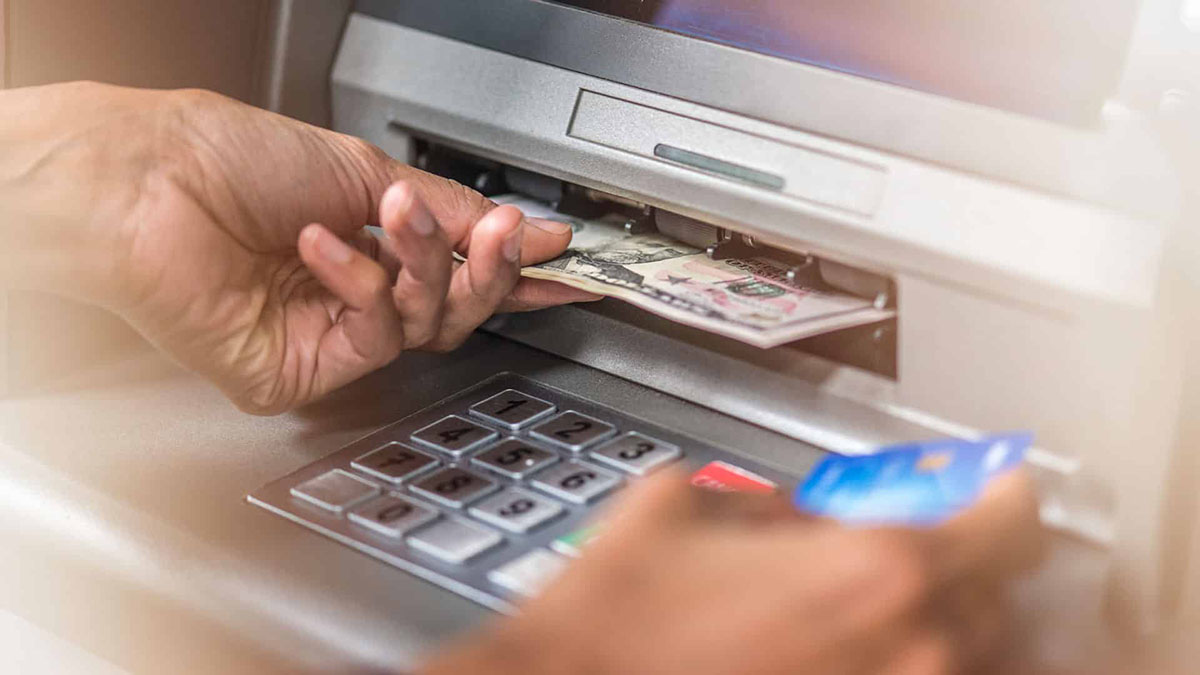Home>Finance>How Would A Bank Secure Itself In Trade Finance


Finance
How Would A Bank Secure Itself In Trade Finance
Modified: March 1, 2024
Looking to secure your bank's trade finance operations? Learn how finance institutions can protect themselves in the dynamic world of trade finance.
(Many of the links in this article redirect to a specific reviewed product. Your purchase of these products through affiliate links helps to generate commission for LiveWell, at no extra cost. Learn more)
Table of Contents
- Introduction
- Risks in Trade Finance
- Traditional Security Measures in Trade Finance
- Digitalization in Trade Finance
- Enhanced Security Measures in Trade Finance
- Role of Blockchain Technology in Trade Finance Security
- Integration of Artificial Intelligence in Trade Finance Security
- Regulatory Framework for Trade Finance Security
- Conclusion
Introduction
Trade finance is a critical component of global commerce, facilitating the movement of goods and services across borders. Banks play a vital role in ensuring the smooth functioning of trade finance operations by providing financial support to importers and exporters. However, the inherent risks associated with trade finance transactions require banks to implement robust security measures to safeguard their interests and protect against fraudulent activities.
Trade finance involves various parties, including buyers, sellers, banks, and shipping companies, making it susceptible to a range of risks such as non-payment, counterfeit documents, and identity theft. These risks not only pose financial threats but can also harm the reputation of banks, impacting their credibility in the market.
To address these challenges, banks have traditionally relied on a range of security measures, including rigorous due diligence, verification of documents, and the establishment of trust-based relationships. However, with the digitization of trade finance, new security challenges and opportunities have emerged, requiring banks to adapt and adopt enhanced security measures.
The digitalization of trade finance has revolutionized the industry, enabling the seamless exchange of documents, reducing paperwork, and increasing the efficiency of transactions. However, it has also introduced new risks, such as cybercrime and data breaches. As a result, banks now need to strike a delicate balance between reaping the benefits of digitalization and ensuring the security of trade finance operations.
Blockchain technology has emerged as a potential game-changer for trade finance security. By providing a decentralized and immutable ledger, it ensures transparency, immutability, and traceability of transactions, reducing the risk of fraud and counterfeiting. Additionally, the integration of artificial intelligence (AI) in trade finance security has the potential to enhance risk assessment and fraud detection capabilities.
Furthermore, regulators worldwide have recognized the significance of trade finance security and have implemented a robust regulatory framework to govern trade finance operations. Compliance with these regulations not only ensures the stability and integrity of the financial system but also strengthens the security measures implemented by banks.
In this article, we will explore the risks associated with trade finance, traditional security measures employed by banks, and the evolving landscape of trade finance security in the digital era. We will also delve into the role of blockchain technology, the integration of artificial intelligence, and the regulatory framework governing trade finance security. By staying ahead of the curve and adopting innovative security measures, banks can secure themselves and their stakeholders in the dynamic world of trade finance.
Risks in Trade Finance
Trade finance transactions involve various risks that can impact the financial stability and reputation of banks. It is crucial for banks to identify and mitigate these risks to safeguard their interests and maintain a secure trade finance ecosystem.
1. Non-payment risk: One of the primary risks in trade finance is the non-payment of goods or services by the buyer. This can occur due to various reasons, including insolvency, economic downturns, or buyer’s unwillingness to fulfill payment obligations. Banks need to assess the creditworthiness of the buyer and implement measures such as credit insurance or letters of credit to mitigate this risk.
2. Document fraud: Trade finance transactions involve a plethora of documents, including invoices, bills of lading, and certificates of origin. Fraudulent alteration, forgery, or submission of counterfeit documents can lead to financial losses for banks. Implementing robust document verification procedures and employing advanced technologies like optical character recognition (OCR) can help banks detect fraudulent documents.
3. Identity theft: Trade finance relies on trust, and establishing the identity of parties involved is essential to prevent fraudulent activities. Identity theft can occur when a fraudster impersonates a legitimate party, leading to financial losses or unauthorized transactions. Banks should have stringent Know Your Customer (KYC) procedures and implement digital identity verification methods to mitigate the risk of identity theft.
4. Supply chain disruptions: The global nature of trade finance exposes banks to supply chain disruptions, such as geopolitical conflicts, natural disasters, or trade policy changes. These disruptions can impact the timely delivery of goods and payment, leading to monetary losses. Assessing the resilience of the supply chain, diversifying sourcing options, and implementing contingency plans can help banks mitigate this risk.
5. Regulatory and compliance risks: Compliance with international trade regulations, sanctions, and anti-money laundering (AML) measures is crucial for banks engaging in trade finance. Non-compliance can result in hefty fines, reputational damage, and even legal action. Banks need to maintain a robust compliance framework, conduct regular audits, and stay updated with the evolving regulatory landscape to manage this risk effectively.
6. Cybersecurity risks: With the increasing digitization of trade finance operations, banks are vulnerable to cyber threats, such as hacking, data breaches, and ransomware attacks. These risks can compromise sensitive customer information, disrupt operations, and lead to financial losses. Implementing strong cybersecurity measures, including encryption, multi-factor authentication, and regular security audits, is essential to safeguard against cyber threats.
By understanding and addressing these risks, banks can establish a secure trade finance environment, protect their financial interests, and maintain the trust of their stakeholders.
Traditional Security Measures in Trade Finance
Trade finance has a long history, and over time, banks and financial institutions have developed traditional security measures to mitigate risks and ensure secure transactions.
1. Due diligence: Banks conduct thorough due diligence on the parties involved in the trade finance transaction. This includes verifying the buyer’s creditworthiness, assessing the reputation and track record of the seller, and evaluating the overall financial stability of the transaction. This helps banks mitigate the risk of non-payment and fraudulent activities.
2. Letters of credit (LC): Letters of credit are widely used in trade finance to provide a secure payment guarantee to the seller. The banks issue an LC on behalf of the buyer, stating that the payment will be made upon satisfactory delivery of goods or services. This minimizes the risk of non-payment and provides assurance to the seller that they will receive payment.
3. Document verification: Banks meticulously verify the authenticity and accuracy of trade documents such as invoices, bills of lading, and certificates of origin. This involves scrutinizing the details, cross-checking with relevant authorities, and ensuring compliance with international trade regulations. By ensuring the integrity of the documents, banks reduce the risk of fraud and document forgery.
4. Trade finance insurance: Banks often recommend or provide trade finance insurance options to their clients. These insurance policies cover various risks, including non-payment, political and credit risks, and physical damage to goods. This provides an added layer of security and reassurance to both buyers and sellers in trade finance transactions.
5. Collateral requirements: In some cases, banks may require collateral from the buyer or seller to secure the trade finance transaction. This collateral could be in the form of property, inventory, or financial assets. By having collateral, banks ensure they have a means of recovering their funds in case of default or non-payment.
6. Trust-based relationships: Building strong and trust-based relationships with key players in the trade finance ecosystem is crucial. Banks often work with reliable and established intermediaries such as shipping companies, inspection agencies, and legal entities to ensure the smooth flow of trade finance operations. Trust-based relationships enhance transparency, reduce the risk of fraud, and facilitate effective risk management.
While these traditional security measures have been effective in managing risks in trade finance, the digital transformation of the industry necessitates the adoption of enhanced security measures to address the evolving challenges and opportunities in the digital era.
Digitalization in Trade Finance
The advent of digitalization has revolutionized the trade finance industry, driving efficiency, speed, and transparency in transactions. Digitalization in trade finance refers to the use of technologies and digital platforms to streamline processes, facilitate secure document exchange, and automate various trade finance operations.
1. Electronic Documentation: One of the significant advancements in digitalization is the transition from paper-based documentation to electronic documentation. By digitizing trade documents such as invoices, bills of lading, and certificates of origin, trade finance operations have become more efficient, reducing delays, paperwork, and the risk of document loss or manipulation.
2. Electronic Data Interchange (EDI): EDI enables the electronic exchange of structured trade data between various stakeholders in the trade finance ecosystem. This eliminates the need for manual data entry, reduces errors, and accelerates the processing of trade finance transactions. EDI also enhances data security by encrypting sensitive information and ensuring secure data transmission.
3. Online Platforms: The emergence of online platforms has enabled buyers, sellers, and banks to collaborate and manage trade finance transactions more effectively. These platforms facilitate the digital exchange of documents, automate processes such as credit checks and risk assessments, and provide real-time visibility into the progress of transactions. Online platforms also offer enhanced security features, ensuring that only authorized parties can access and modify trade-related information.
4. Digital Payment Systems: Digitalization has facilitated the adoption of faster and more secure payment systems in trade finance. Technologies such as online banking, mobile payments, and digital wallets enable instant and secure fund transfers, reducing the reliance on traditional paper-based methods. This enhances the efficiency of trade finance transactions and minimizes the risk of payment delays or non-payment.
5. Track and Trace Technologies: Digitalization has introduced track and trace technologies that allow real-time monitoring of the movement of goods along the supply chain. Technologies such as Internet of Things (IoT) devices, barcode scanning, and GPS tracking enable stakeholders to track the location, condition, and authenticity of goods, mitigating the risk of fraud, theft, or counterfeiting.
6. Data Analytics: Digitalization has empowered banks to harness the power of data analytics for improved trade finance decision-making. Advanced analytics tools process large volumes of trade-related data to identify patterns, trends, and potential risks. By leveraging data analytics, banks can enhance risk assessment capabilities, detect anomalies, and make informed decisions based on reliable insights.
Overall, digitalization in trade finance has streamlined processes, increased efficiency, reduced costs, and enhanced security. However, it has also introduced new cybersecurity risks, requiring banks to adopt advanced security measures to safeguard digital trade finance operations.
Enhanced Security Measures in Trade Finance
As trade finance continues to evolve in the digital era, banks are adopting enhanced security measures to protect against emerging risks and ensure the integrity of trade finance transactions. These measures leverage technology, advanced authentication methods, and sophisticated risk assessment techniques to enhance security and reduce the potential for fraudulent activities.
1. Two-Factor Authentication (2FA): Two-factor authentication adds an extra layer of security by requiring users to provide two forms of identification to access trade finance platforms or authorize transactions. This typically involves combining something the user knows (such as a password) with something the user possesses (such as a mobile phone), making it more difficult for unauthorized individuals to gain access to sensitive information or conduct unauthorized transactions.
2. Secure Digital Platforms: Banks are adopting secure digital platforms that adhere to industry best practices in terms of encryption, secure socket layer (SSL) certificates, and other security protocols. These platforms provide a secure environment for the exchange of trade documents, financial information, and communication between buyers, sellers, and banks.
3. Advanced Fraud Detection Systems: Banks are utilizing advanced fraud detection systems that leverage machine learning and artificial intelligence algorithms to analyze historical transaction data, detect patterns, and identify potential fraudulent activities. These systems can flag suspicious transactions, validate trade documents, and provide an additional layer of security against fraudulent activities in trade finance.
4. Biometric Authentication: Biometric authentication technologies such as fingerprint scans, facial recognition, and voice recognition are being increasingly utilized to enhance security in trade finance. These authentication methods provide a higher level of security as they are unique to each individual, making it difficult for unauthorized parties to gain access to sensitive information or conduct fraudulent transactions.
5. Data Encryption: Encryption of trade data is a crucial security measure to protect sensitive information from unauthorized access. Encryption algorithms are used to convert data into a coded format that can only be decrypted with the appropriate decryption key. This ensures that even if data is intercepted, it remains unintelligible to unauthorized individuals.
6. Continuous Monitoring and Auditing: Banks are adopting continuous monitoring and auditing processes to identify and address potential security vulnerabilities in trade finance operations. Regular audits of systems, processes, and security controls help ensure that any weaknesses or vulnerabilities are identified and remediated promptly to maintain the security and integrity of trade finance transactions.
By implementing these enhanced security measures, banks can significantly reduce the risk of fraud, unauthorized access, and other security threats in trade finance. However, it is crucial for banks to stay vigilant, stay updated with emerging threats, and adapt their security measures accordingly to maintain a secure trade finance ecosystem.
Role of Blockchain Technology in Trade Finance Security
Blockchain technology has emerged as a revolutionary solution for enhancing security in trade finance. Blockchain, often referred to as a decentralized and immutable ledger, offers several unique features that mitigate risks and enhance the security of trade finance transactions.
1. Tamper-Proof Transactions: Blockchain utilizes cryptographic algorithms to create a secure and transparent environment for trade finance transactions. Once a transaction is recorded on the blockchain, it cannot be altered or tampered with, providing an immutable and auditable record of each transaction. This feature reduces the risk of fraud and ensures the integrity and transparency of trade finance operations.
2. Smart Contracts: Smart contracts are self-executing contracts with predefined conditions and terms written directly into the blockchain. In trade finance, smart contracts can automate payment flows and ensure that funds are released only when predetermined conditions are met. By removing the need for intermediaries and manual intervention, smart contracts reduce the risk of human error, provide real-time visibility, and enhance the security of trade finance transactions.
3. Enhanced Transparency and Traceability: Blockchain offers a decentralized and transparent ledger where all participants can view and verify transactions. This enhances trust and reduces the risk of fraudulent activities by enabling participants to trace the origin, ownership, and movement of goods throughout the supply chain. With blockchain, banks can more effectively verify the authenticity of trade documents and mitigate the risk of document fraud.
4. Disintermediation and Reduced Counterparty Risk: Traditional trade finance often involves multiple intermediaries, increasing the risk of errors, delays, and fraud. By utilizing blockchain, trade finance transactions can be executed directly between buyers and sellers, eliminating the need for intermediaries. This reduces counterparty risk by ensuring that transactions are based on verified and immutable data, improving the overall security and efficiency of trade finance transactions.
5. Secure Data Sharing: Blockchain offers a secure and transparent platform for data sharing among authorized parties. With cryptographic encryption and decentralized storage, sensitive trade data can be securely shared, reducing the risk of unauthorized access and data breaches. This secure data sharing capability enhances collaboration and trust among stakeholders in trade finance.
6. Improved Anti-Money Laundering (AML) Compliance: Blockchain technology can help banks comply with anti-money laundering regulations by providing a transparent record of transactions. By analyzing transaction patterns and data on the blockchain, banks can detect and prevent potential money laundering activities more effectively. This strengthens the overall security and integrity of trade finance operations.
The implementation of blockchain technology in trade finance is still in its early stages, but it holds immense potential to transform the security landscape. By leveraging blockchain’s decentralized, tamper-proof, and transparent nature, banks can enhance security, reduce risks, and ensure the seamless flow of trade finance transactions.
Integration of Artificial Intelligence in Trade Finance Security
The integration of artificial intelligence (AI) in trade finance security has the potential to revolutionize risk assessment, fraud detection, and overall security measures in the industry. AI technologies, including machine learning and natural language processing, can analyze vast amounts of data, identify patterns, and make intelligent decisions, improving the efficiency and effectiveness of trade finance security.
1. Risk Assessment: AI algorithms can analyze historical trade data, market trends, and risk indicators to assess the creditworthiness of buyers and sellers. By leveraging machine learning techniques, AI can identify patterns and predict potential risks, enabling banks to make informed decisions and mitigate the risk of non-payment or fraud. AI-powered risk assessment models enhance the speed and accuracy of risk evaluation, facilitating secure trade finance transactions.
2. Fraud Detection: AI algorithms can analyze large volumes of trade data, including transaction records, trade documents, and customer profiles, to identify patterns indicative of fraudulent activities. By using machine learning to detect anomalies and suspicious behaviors, AI can help banks prevent fraud, document forgery, and identity theft in trade finance transactions. Real-time monitoring and continuous learning capabilities of AI systems enable banks to stay one step ahead of fraudulent activities.
3. Intelligent Document Processing: Trade finance involves a multitude of documents that need to be processed, verified, and validated. AI technologies can automate document processing tasks using optical character recognition (OCR) and natural language processing (NLP) techniques. This improves the efficiency of document verification, reduces errors, and enables smoother trade finance operations. AI-powered document processing also enhances security by detecting fraudulent or altered documents.
4. Behavioral Analytics: AI can analyze customer behavior patterns, transaction history, and other relevant data to establish baseline behavior and detect deviations from normal patterns. By identifying suspicious activities or abnormal behaviors, AI systems can flag potential risks or fraudulent transactions. This behavior-based approach to security adds an extra layer of protection against new and evolving threats in trade finance.
5. Customer Due Diligence: AI technology can automate the due diligence process by conducting extensive searches and analysis of customer information. By using natural language processing and big data analytics, AI systems can quickly verify customer identities, assess their reputations, and check for any potential red flags. This streamlines the customer onboarding process while ensuring compliance with regulatory requirements and enhancing the security of trade finance operations.
6. Cybersecurity and Network Protection: AI can also play a critical role in safeguarding trade finance operations against cyber threats. AI-powered cybersecurity systems can monitor network traffic, detect suspicious activities, and respond proactively to potential attacks. By continuously analyzing and learning from cybersecurity incidents, AI systems can improve the resilience and security of trade finance networks.
The integration of AI in trade finance security brings significant advantages in terms of speed, accuracy, and proactive risk management. However, it is important for banks to ensure that AI models are properly trained, validated, and regularly updated to adapt to changing security threats and new types of fraudulent activities in trade finance.
Regulatory Framework for Trade Finance Security
The security of trade finance transactions is a critical concern for regulators worldwide. To ensure the stability, integrity, and security of trade finance operations, regulatory frameworks have been established to govern the industry and guide banks in mitigating risks effectively. These regulations aim to protect the interests of all stakeholders involved in trade finance, including banks, buyers, sellers, and the overall financial system.
1. Know Your Customer (KYC) Requirements: Regulators mandate that banks implement robust KYC procedures to verify the identity of their customers and assess their suitability for trade finance transactions. KYC requirements include gathering relevant identification documents, conducting background checks, and reassessing customer profiles periodically. These measures help prevent money laundering, terrorist financing, and other illicit activities in trade finance.
2. Anti-Money Laundering (AML) Measures: AML regulations require banks to adopt measures to detect and prevent money laundering in trade finance operations. Banks are expected to establish comprehensive AML compliance programs, monitor transactions for suspicious activities, and report any potential instances of money laundering to the appropriate authorities. By promoting transparency and accountability, AML measures enhance the security and integrity of trade finance transactions.
3. Trade Finance Regulation: Some jurisdictions have specific regulations governing trade finance operations. These regulations provide guidelines on documentation requirements, risk management practices, and mitigating fraud in trade finance. Compliance with these regulations is essential for banks to ensure secure and legally compliant trade finance operations.
4. International Trade Regulations: International trade regulations, such as those issued by the World Trade Organization (WTO) and International Chamber of Commerce (ICC), provide a framework for trade finance security. These regulations cover areas such as the use of standard trade documents, compliance with international trade protocols, and dispute resolution mechanisms. Adherence to these regulations promotes consistency, transparency, and security in trade finance transactions.
5. Cybersecurity Regulations: With the increasing digitalization of trade finance, regulators have also emphasized the need for robust cybersecurity measures. Regulatory frameworks require banks to adopt appropriate security measures to protect trade finance networks, customer data, and financial information. Compliance with cybersecurity regulations helps mitigate the risk of data breaches, unauthorized access, and cyberattacks in trade finance operations.
6. Enhanced Reporting and Disclosure: Regulators often require banks to maintain comprehensive records of trade finance transactions and promptly report any suspicious activities or potential fraud. This facilitates regulatory oversight and enables authorities to monitor the security and integrity of trade finance operations. Enhanced reporting and disclosure requirements contribute to maintaining a secure and transparent trade finance ecosystem.
Compliance with the regulatory framework is essential for banks to ensure effective security measures in trade finance operations. By adhering to these regulations, banks can mitigate risks, protect stakeholders’ interests, and contribute to an environment of trust and stability in trade finance.
Conclusion
The security of trade finance operations is of paramount importance to banks and stakeholders involved in global commerce. With the evolving landscape of trade finance, traditional security measures have been supplemented by advanced technologies and regulatory frameworks to safeguard transactions and mitigate risks.
Incorporating digitalization in trade finance has brought numerous benefits, such as streamlined processes, reduced paperwork, and increased efficiency. However, it has also introduced new risks, necessitating the adoption of enhanced security measures. Blockchain technology has emerged as a significant enabler of secure trade finance, ensuring transparency, immutability, and traceability of transactions.
The integration of artificial intelligence (AI) in trade finance security enhances risk assessment capabilities, fraud detection, and customer due diligence. AI-powered systems can analyze vast amounts of data, identify patterns, and enhance the efficiency and effectiveness of security measures in trade finance.
Regulatory frameworks play a crucial role in guiding banks in implementing robust security measures. Regulations related to KYC, AML, trade finance operations, international trade, and cybersecurity ensure compliance, transparency, and accountability in trade finance transactions.
In conclusion, securing trade finance requires a combination of traditional security measures, technological advancements, and regulatory compliance. By embracing digitalization, harnessing the power of blockchain and AI, and adhering to regulatory frameworks, banks can safeguard trade finance operations, protect stakeholders’ interests, and maintain the integrity and security of the global trade ecosystem.














